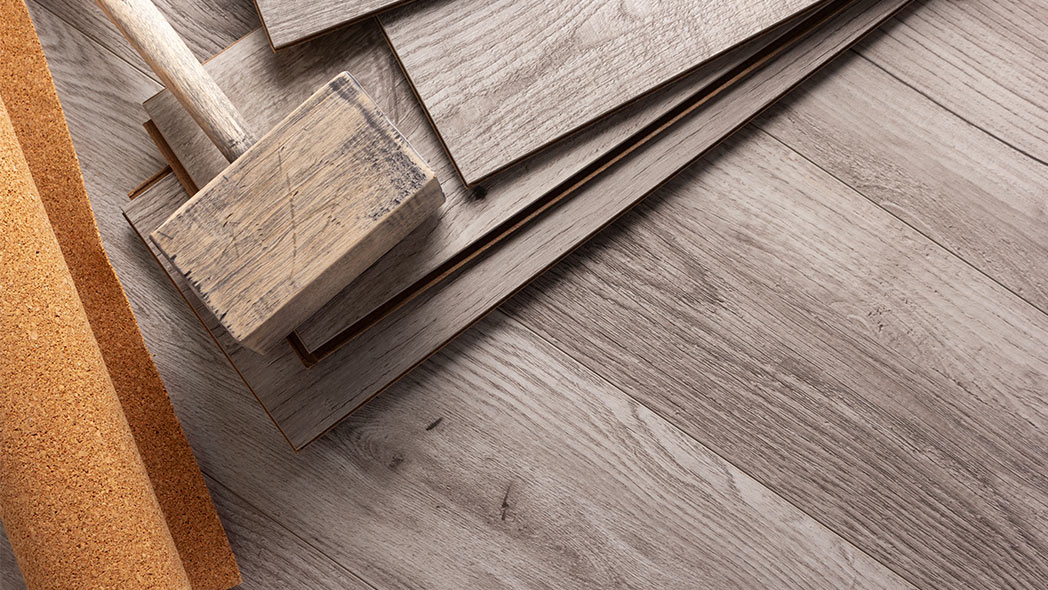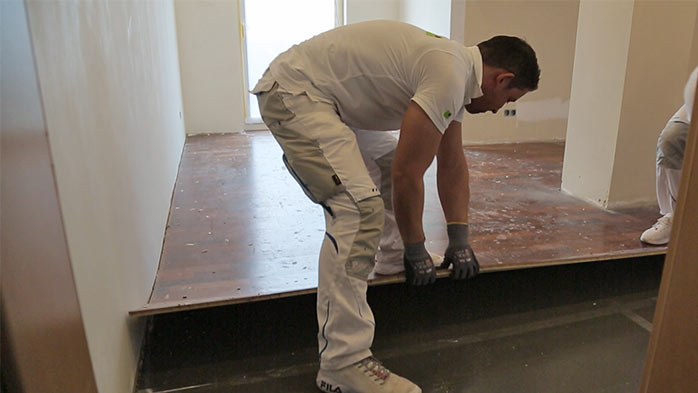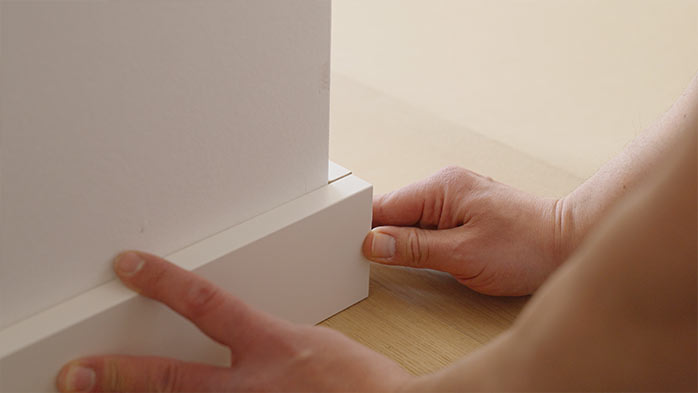
Photo: Seregarm / iStock.com
Are you looking to give your aged laminate flooring a new look? With click and adhesive vinyl, this can be achieved quickly, cost-effectively, and without the need for significant DIY skills. However, when laying the flooring, there are several factors you need to consider. Most importantly, you should steer clear of the idea of laying the vinyl directly on top of the laminate flooring. While technically feasible and recommended in DIY magazines as a time-saving trick, it does not offer a long-term solution and can lead to a host of problems. In the worst-case scenario, a complete reinstallation of the floor may even be necessary. Below, we discuss the problems that can arise when installing vinyl flooring over laminate and how to properly approach renewing your floor from the start.
Content
Why It's Not a Good Idea to Lay Vinyl Flooring Over Laminate
Is it possible to lay click or adhesive vinyl flooring over laminate? This question is commonly asked by DIY enthusiasts, especially when renovations are required in a rented apartment or when the time frame for renewing the floor is limited. The reasons are obvious: laying vinyl over laminate eliminates the time needed for removing and disposing of the old floor, and it generates minimal mess. Also, a often complex and costly preparation of the subfloor (e.g., applying a leveling compound to even out irregularities) is not necessary when laying vinyl directly on laminate. Sounds good, so what's the downside to saving money and time on the installation? There are several reasons, starting with the movement and expansion of the materials, to restrictions on the use of underfloor heating.
A Shaky Business: Laying Click Vinyl as a Floating Floor Over Laminate
High-quality click vinyl, like that from planeo, can be quickly and easily laid on almost any subfloor. Like laminate, click vinyl is also laid as a floating floor. This means you should leave approximately one centimeter of space at the sides next to the wall. This gap allows the material to expand or contract depending on the temperature and humidity in the room. The ability to "work" prevents damage, for example, from tension. However, it becomes problematic when you lay one floating floor covering over another floating floor covering, as in this case with vinyl over laminate. The stability of the floor is not guaranteed since the coverings move independently of each other. Over time, this opposing movement can lead to various undesirable effects such as clattering, squeaking, or, in the worst case, joint formation. This means that laying click vinyl on laminate is by no means recommended.
Vinyl Over Laminate: Increased Floor Height Can Cause Problems
Another issue with laying two floor coverings like vinyl and laminate on top of each other is the increase in floor height. This refers to the height of the floor covering (including vapor barrier, impact sound insulation, etc.) and affects doors, transitions, and furniture. Usually, these are only designed for the height of one floor covering. An increase in floor height due to an additional floor covering could lead to various problems. For example, it may be necessary to shorten the doors or frames, which in rental apartments is not possible without the landlord's consent. Additionally, a significant height difference could occur at the transition from one room to another, which you would need to even out with a transition profile. Over time, this could become a tripping hazard. Last but not least, increased floor height can cause issues when planning fitted kitchens, as the height of the countertop, among other things, changes.
Laying Vinyl Over Laminate Despite Underfloor Heating?
Underfloor heating provides living comfort and efficient heating, provided the floor covering is compatible and allows for even heat distribution. Laying several floor coverings on top of each other can impair the efficiency of the heating, as with each additional layer, the so-called thermal resistance increases, making it increasingly difficult for heat to pass through the layers into the room air. The underfloor heating struggles particularly when you lay vinyl including impact sound insulation over an existing laminate floor. Therefore, you should always remove the laminate floor. It's doubly beneficial because vinyl has an excellent thermal resistance. This means the room air warms up very quickly and cools down rapidly when necessary.
Good to know: An exception is made for tiles when laying a new vinyl floor. Ceramic materials conduct heat very well, so they can remain in place if you're laying a new vinyl floor, provided the tiles are firmly attached and do not have significant damage such as cracks.
Tip: The most efficient method is to use adhesive vinyl in combination with underfloor heating. In this case, no additional insulating layer is used between the vinyl and the floor, so no air pockets can form that reduce the transfer of thermal energy and thus impair efficiency.

Exception: Laying Vinyl Over Parquet
Unlike laminate or click parquet, you can lay vinyl flooring over glued or nailed parquet flooring. Click vinyl is particularly suitable here, as it is easy to lay and can be quickly and residue-free dismantled if necessary (e.g., when moving out of a rental property or selling the property). However, it is important that the parquet floor is in good condition, i.e., it does not have any cracks, holes, or irregularities that could transfer to the vinyl floor and damage it in the long term. If necessary, you must fill these in advance with a suitable filler.
Between the parquet and the vinyl floor, you should also lay impact sound insulation to ensure a pleasant walking sound. Alternatively, you can lay rigid vinyl. The insulation is often already integrated into the rigid vinyl. This saves time and makes it easier to give the floor a fresh look. Otherwise, laying vinyl over parquet also leads to increased floor height and a reduction in the efficiency of underfloor heating.
Laying Vinyl Flooring: The Right Way
Laying vinyl over laminate is not a long-term solution. Therefore, we recommend removing the laminate floor completely and laying the click or adhesive vinyl directly on the subfloor. Proceed as follows:
- Remove the old laminate floor, including impact sound insulation.
- Thoroughly clean the subfloor of dust, dirt, and other residues.
- Check if the floor is level. Even out any irregularities with a leveling compound.
- Lay the impact sound insulation (if not already integrated into the click vinyl floor).
- Apply adhesive to the floor for adhesive vinyl flooring. For bonded installation, the screed must always be primed and levelled.
- Now start laying the vinyl floor, plank by plank or tile by tile.
- Finally, fit skirting boards all around for a perfect finish.
Tip: Old laminate, including impact sound insulation, can be disposed of (up to a certain amount free of charge) at your local recycling center.

Conclusion: Laying Vinyl Over Laminate May Seem to Save Time and Money at First Glance
Laying vinyl over a laminate floor to save time and money is not a good idea. In addition to the increased floor height, which can cause problems at doors and transitions, the floating installation of the two floors is a weak point. In the worst case, this can lead to cracks in the new vinyl floor or the planks or tiles separating and and thus joint formation occurs. Thus, a complete reinstallation may eventually be necessary, consuming additional time and money. Last but not least, the efficiency of underfloor heating can be reduced by combining vinyl and laminate. Therefore, at planeo, we recommend removing the old laminate floor when renovating the floor with vinyl. The effort is usually manageable, and the flawless result rewards the trouble.
Experience the best service with planeo - because you need it!
No matter what challenges you face with your project, planeo provides you with the right solution. Benefit from the advantages of our services:
- Free samples for many of our products: Order up to 7 samples at no cost, for example, from our vinyl flooring, click vinyl, adhesive vinyl or SPC flooring.
- Express delivery - for urgent projects and quick decisions.
- Expert advice - We offer professional consultation through our contact page or answer your questions directly in the comments.
These topics might also interest you
Rigid Vinyl (SPC Vinyl) - What makes it so special?
Adhesive vinyl flooring - 4 ways to install adhesive vinyl
Impact sound insulation vinyl - Which vinyl floor underlayment to take?